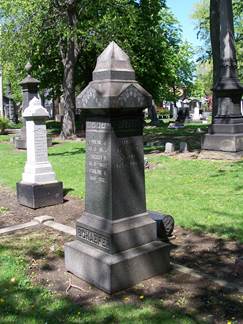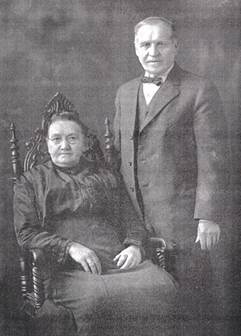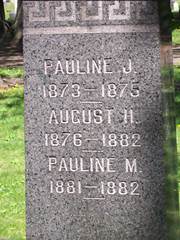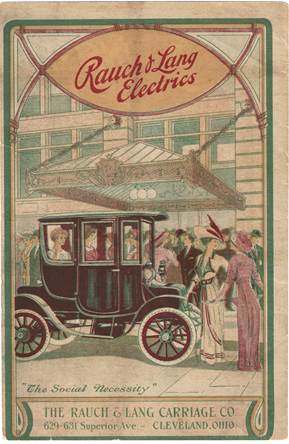Gustav Schaefer 1845 - November 1, 1936
Maria Schaefer 1847 - April 10, 1931
Putting the Cart Behind the Horse
Gustav Schaefer was born in Willmenrod, Germany in 1845 and emigrated to the US in 1866. His wife, Maria (Mary) was born in 1847, also in Germany, and emigrated to the US in 1872. Gustav held several jobs after arriving in Cleveland but became so interested in carriage-making that in 1880 he opened his own carriage works on Lorain Street just west of Randall Street. Gustav and Mary lived in a house right next door to Gustav’s manufacturing business. They gave birth to two sons, Henry and Ernst, and three daughters, Mary, Louise and Anna. As you will see in the excerpt that follows Gustav’s company’s specialty was heavy drays and wagons. By 1896, a portion of the manufacturing facility was a “carriage repository” which was the predecessor of the modern automobile showroom. The showroom, most likely, featured examples of the types of vehicles built in the factory, perhaps both custom and common types.

By 1896, a second house had been built in the rear of the property where Gustav and Mary resided. The 1910 census shows Gustav, Mary, their daughter Annie (Age 18) and their son Ernst (Age 26) living in the rear house along with a Hungarian-born boarder (And his wife and daughter) who is listed as a wagon maker, no doubt in Gustav’s factory. Ernst is also shown to be a foreman in a wagon factory. The front house was occupied by Henry Schaefer, Gustav’s son, age 31, and his wife Adeline and daughter Hilda. Another Hungarian-born boarder working as a wagon maker along with his wife and daughter resided in Henry’s house. Henry is also shown to be a foreman in a wagon factory so, apparently, Gustav kept ownership of his business in the family while also providing a place to live and an income for two of his employee.

The Schaefer’s gave birth to as many as six children but, like so many families in the 19th Century, they suffered through the early deaths of three of them –Pauline M. at age one year; Pauline J. at age two years; August H. at age six years. Gustav and Mary were members of Trinity Evangelical Lutheran Church on Jersey Street (W. 30th Street). Gustav and Mary lived long lives with Gustav dying at age 92 and Mary at age 84 and both had funeral services performed at Trinity. (See #29, Ludwig & Barbara Hundertmark for additional information on Trinity Evangelical Lutheran Church.) At the time of their deaths they were living at 19340 Lorain Avenue.
Gustav’s business lived on long after him under the guidance of his son Henry. The company eventually became the Schaefer Body Company and continued in business until 1977.

The following was taken from the Encyclopedia of Cleveland History:
Though Cleveland was never home to the massive wagon and carriage factories found in some midwestern cities, it nevertheless possessed large numbers of smaller firms producing virtually every type of horse-drawn vehicle for local and regional markets. More significantly it was home to some of the largest manufacturers and wholesalers of wagon and carriage parts in the U.S. The widespread national distribution of these goods was the city's most important contribution to a leading nineteenth century industry.
Lack of suitable roads in the early community restricted wheeled vehicles to the occasional ox-drawn farm cart and freight wagon, most of which were the products of local farmers and blacksmiths. By 1820 there was a wagon maker located on Public Square, and it was not long before improved roads, expanded commerce, and a growing population created sufficient demand to support a small number of local vehicle builders. Antebellum wagon and carriage manufacture was characterized by small shops consisting of journeymen and apprentices working under the auspices of a master craftsman. Vehicles were normally built to order though some common types might be built ahead to meet an anticipated demand. The work involved little or no machinery and progressed at the slow but steady pace of hand tools and methods.
As it happened elsewhere, Cleveland's trade came to be dominated by skilled foreign-born craftsmen, particularly Germans. Large numbers of these immigrants--many skilled in various trades--began flooding into the region in the 1830s and 1840s establishing a marked presence in crafts such as horse-drawn vehicle manufacture. Augmenting their numbers with fresh arrivals of skilled immigrants and passing down their trade and their shops to their sons, German craftsmen retained their hold on Cleveland's wagon and carriage industry until its demise early in the twentieth century.
One of the first substantial wagon and carriage shops in the city was that owned by Jacob Lowman, who came to Cleveland from Maryland in the early 1830s. Taking over a shop on Seneca (W.3rd) he quickly became the largest wagon and carriage maker in town. One of his early journeymen was Prussian-born John Drumm, who soon established his own shop nearby. Lowman and Drumm were eventually joined by others such as Peter Black, a German who came to Cleveland in the early 1830s and became a successful Cleveland carriage maker. By the middle of the 1840s the community's modest needs were being met by 5 shops, the number fluctuating between 5 and 10 up to the eve of the Civil War. The majority were located near the center of town in the non-residential district south of Superior and the public square, though the expansion of the city saw the spread of shops across the urban landscape.
Though the process of change had begun by mid century it was the postwar period which saw American horse-drawn vehicle manufacturers make their first substantial moves away from craft methods. Readily available steam power, increasingly sophisticated wood- and metalworking machinery, and the application of factory principles marked the transformation of the trade into a full-fledged industry. While handwork and traditional craftsmanship continued to play an important part, they increasingly took a back seat to machine production and a carefully calculated division of labor. Midwestern vehicle makers were particularly well poised to take advantage of this shift because of their proximity to abundant timber and iron ore, regional leadership in iron and steel production, the prolific output of midwestern machine and tool makers, and a growing pool of skilled and unskilled labor.
Cleveland's wagon and carriage trade soon reflected many of these trends in the power and machinery appearing on the work floor and in the growth in number and size of the firms themselves. The postwar period saw the first significant increase in Cleveland's vehicle manufacturing sector: in 1870 there were 16 separate firms, but just 6 years later the total jumped to nearly 50. Some of these had antebellum roots, others were entirely new. William Gabriel set up shop in Cleveland in 1850 and gradually brought his sons into the business; when they took over after his death in 1877 the shop had been producing a wide range of wagons and carriages for many years. Bavarian Jacob Hoffman established a similar shop sometime during the 1860s; he too became a locally prominent vehicle builder. John Green began as a St. Louis carriage maker before moving to Cleveland in the early 1870s. He was one of the first in Cleveland to open a carriage repository, the nineteenth century equivalent of the automobile showroom.
Gustav Schaefer was a German-born wagon maker who came to Cleveland just after the Civil War. After work at stone quarrying, barrel making, and in various local wagon and carriage shops, he realized the dream of owning his own firm in 1880. Though he began by producing many different styles of horse-drawn vehicles he eventually specialized in heavy drays and wagons. Jacob Rauch also came from Germany to Cleveland and opened a blacksmith and wagon shop here in 1853. Jacob died in 1862 leaving the business to his son Charles. Charles achieved early success in the manufacture of ice wagons, one of which received a bronze medal at the Centennial Exposition in Philadelphia in 1876. In 1884 he took on Charles E. Lang as a partner and expanded his output to include many kinds of vehicles. Besides their well-regarded delivery wagons the firm was also becoming the single leading area manufacturer of heavy carriages for the luxury market. Rauch & Lang broughams, victorias, and opera busses routinely saw use by the local elite and helped ensure their place as the single best remembered Cleveland carriage maker.
The 1870s and 1880s saw the rise of enormous wagon and carriage factories which began mass producing inexpensive vehicles for the wholesale market. Though they soon spread to other parts of the country, this style of manufacture originated in Cincinnati and remained prevalent in several other midwestern cities. While Cleveland never hosted large wholesale vehicle factories, it was home to some of the world's largest producers of wagon and carriage parts which became vital to carriage shops and factories of all sizes. Widespread application of machinery and factory principles from mid century onward had encouraged the separate manufacture of nearly every part used in the construction of a typical wagon or carriage. Cleveland's proximity to raw materials, labor, and excellent shipping facilities made it an ideal location for such specialty manufacturers, dozens of whom were established here over the last quarter of the century.
Some, like the Cleveland Bending Works, specialized in the production of bent wood vehicle parts such as shafts, reaches, and top bows. Others took advantage of the mature local iron and steel industry to produce vehicle parts from iron and steel including springs, bow sockets, dashboard frames, fifth wheels, and hundreds of others. The I. N. Topliff Manufacturing Company was a pioneer in the construction of hollow steel bow sockets used in folding buggy tops, and their goods soon became vital to thousands of carriage shops and factories. The Cleveland Dash Co. made carriage dashboards, the Cleveland Spring Co. and the Forest City Spring Works made suspension components, and the Cleveland Axle Mfg. Co. produced wagon and carriage axles. New advances in iron castings permitted the economical production of hundreds of different vehicle parts from malleable iron castings. Cleveland was a leader in this field as well, primarily through the work of the Cleveland Malleable Iron Co., a large foundry which came into existence in 1868. In 1879, company president Alfred A. Pope established the Eberhard Manufacturing to make and market malleable iron castings for the wagon and carriage industry. These quickly became a mainstay in horse- drawn vehicle construction, and Eberhard soon became the world's largest producer of them. The Cleveland Hardware Co. was another sizeable concern which made vast quantities of wagon and carriage hardware from rolled sheet steel and was foundational in the development of drop forged vehicle parts
By the 1880s and 1890s Cleveland boasted a mature and productive vehicle industry with a wide variety of firms scattered across both sides of the city. Many had come to specialize in a particular vehicle type. While a handful of makers like Gabriel, Lowman, and Rauch & Lang built expensive luxury carriages for the local industrial and financial elite, many more concentrated on commercial vehicles for area merchants, breweries, ice companies, and dairies. Their output consisted of light sprung wagons for the delivery of groceries and other dry goods as well as heavier open and closed wagons and drays for the delivery of milk, beer, and ice. Several Cleveland concerns such as Hoffman, the Broc Carriage & Wagon Co., the Olstyn Carriage Co., Schaefer, and Rauch & Lang produced large numbers of them for local and regional buyers. Some were fortunate enough to secure contracts for the construction of entire fleets for breweries and ice companies; many splendidly decorated ice wagons provided excellent advertisements for the wares of a mature and sophisticated industry. Cleveland had a few small scale makers of cheap buggies as well as several dealers in buggies made by wholesale factories in Columbus, Cincinnati, and elsewhere. Finally, a few shops specialized in vehicle painting while others concentrated on repair work.
Cleveland's wagon and carriage industry peaked at the turn of the century with over 80 firms producing vehicles and a couple dozen more turning out parts and ancillary goods. But by this time the automobile had made its first tentative appearance and the rise of an American automotive industry both in Cleveland and in Detroit quickly put horse-drawn vehicle manufacture into permanent decline. While a few Cleveland wagon and carriage makers such as Broc, Brown Carriage & Auto Co., the DeMars Electric Vehicle Co., and Rauch & Lang attempted to produce autos, none were able to succeed for long in the fiercely contested market. Most lacked the engineering skills and equipment needed to successfully manufacture a form of transportation which relied more on metal than on wood in its construction. Wagon and carriage makers experienced varying degrees of success in making automobile and truck bodies, at least one surviving into the 1970s as a manufacturer and repairer of custom truck bodies, the Schaefer Body Co. Best suited to survive the transition were the wagon and carriage parts makers. Already possessing the skills and machinery to manufacture metal parts, firms such as Eberhard and Cleveland Hardware began making and selling auto parts, and the descendants of these firms continue to make Cleveland one of the leading U.S. auto parts manufacturing cities. Most wagon and carriage shops simply filled their last orders, discharged their work force, and liquidated their assets in the face of a sea change in American transportation. By 1916 the number of Cleveland horse-drawn vehicle firms was down to less than 40 and dropping fast. Continued use of wagons for some commercial applications such as milk delivery helped a few to survive into the 1920s, and it was another twenty years before the last wagon maker disappeared from the city directory. But long before then the horse-drawn vehicle and the industry which produced it had become a thing of the past.

The following was taken from the Encyclopedia of Cleveland History:
Schaefer Body, Inc., initially specializing in custom-made wagons and carriages, grew with the automotive industry building auto and truck bodies and supplying related services. From its beginnings as Schaefer & Eckhardt in 1880, immigrant Gustav Schaefer, a skilled wagon wheel maker, acquired $800 in working capital and organized the Gustav Schaefer Wagon Works on Lorain Avenue to produce wagon bodies. By 1913 the firm was also making automobile bodies and in 1917 it incorporated as the Gustav Schaefer Wagon Company. In the 1920s the company responded to the changing times by building commercial auto and truck bodies of all types and adding services such as wheel repairing and auto painting and trimming. The company name was shortened to the Schaefer Body Company in 1926. After a fire destroyed the plant in 1927, the company, crippled by the Depression, went into receivership and had its assets sold at public auction in 1935. Financed with Cleveland capital, the company reorganized as the Schaefer Body, Inc., with Gustav’s son, Henry, as president, and relocated to superior Avenue on the east side.
By 1964 Schaefer had augmented its custom body work by repairing truck, trailer, and auto bodies and providing contract maintenance for fleets. It was also a major sales and service outlet for new equipment. Although new management tried to strengthen Schafer Body’s distribution and service operation in 1972, the company had a variety of problems and closed in 1977. All assets, including equipment and machinery, were liquidated.